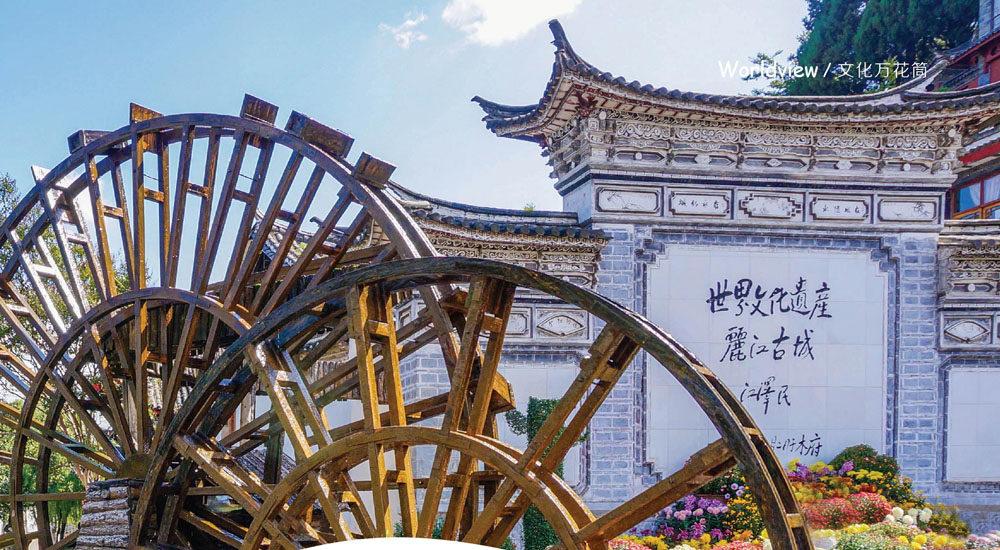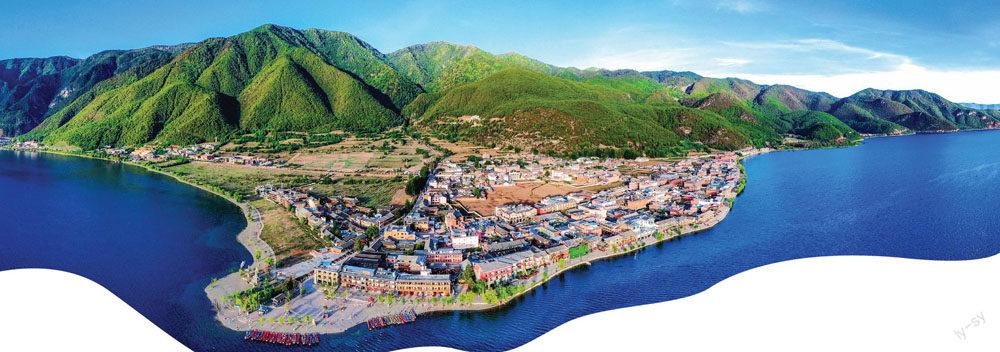Old Town of Lijiang 丽江古城
2022-05-30许林玉
许林玉



麗江古城位于中国云南省丽江市,始建于宋末元初。丽江拥有古老的城市供水系统,这一系统依山就势、纵横交错,至今仍在有效地发挥作用。这座高原之上的古城呈现出一派家家淌清泉、户户垂青柳的水乡景观。作为古城风貌整体保存完好的典范,1997 年,丽江古城被联合国教科文组织列入世界文化遗产名录。
The Old Town of Lijiang is located on the Lijiang plain in southwestYunnan, China. It is perfectly adapted to the uneven topography of thiskey commercial and strategic site, and has remained a historic townscape of high quality and authenticity. Its architecture is famous for the blending of elements from several cultures that have come together over many centuries. Lijiang also 1) possesses an ancient water-supply system of great complexity and ingenuity that still functions effectively today.
The Old Town of Lijiang is made up of three parts: Dayan Old Town (including the Black Dragon Pond), Baisha and Shuhe housing clusters . DayanOld Town was setupin theMingDynasty as a commercial centre. Large numbers of two-storeyed, tile-roofed, timber- framed houses 2)combining elements of Han and Zang architecture and decoration in the arched gateways, screen walls, courtyards and carved roof beams are symbols of the Naxi culture and are disposed in rows following the contours of the mountainside. Wooden elements are finely carved with domestic and cultural elements—pottery, musical instruments,flowers and birds.
The Baisha housing cluster, built earlier during the Song and YuanDynasties, is located 8km north of the Dayan Old Town . Houses here are 3)arranged on a north-south axis around a central, terraced square. Together with the Shuhe housing cluster located 4km north-west of Dayan Old Town, these settlements in mountains and surrounded by water 4)relect the blend of local cultures, folk customs and traditions overseveral centuries.
The three parts of the Old Town of Lijiang fully reflect the social,economic and cultural features of the different periods, following thenatural topography of mountains and water sources to form an outstandingsettlement combining the residential traditions of Naxi, Han, Bai andTibetan people.
The Old Town of Lijiang has 5)integrated the mountains, rivers, trees and architecture to create a human habitat featuring the harmonious unity between man and nature. With mountain ranges as the protective screen in the north and the vast plains in the east and south, the Old Town enjoys a perfect geometrical relationship and ecological layout. A forked water system originates from the snow-capped mountain and runs through the villages and the farmland. Heilong Pool and the scattered wells and springs constitute a complete water system, meeting the needs for fire prevention, daily life and production in the town. Water plays an important role in the Old Towns unique architectural style, urban layout and landscape as the main street and small alleys front onto the canals and some buildings and numerous bridges are constructed across the canals. As an excellent example of human habitat showing a 6)harmony betweenman and nature, the Old Town is also a remarkable example of human'screativity in land use.
From the 12th century onward, the Old Town of Lijiang was an important goods distribution center for trade between Sichuan, Yunnan and Tibet, and is where the Silk Road in the south joins the Ancient Chama (Tea and Horse) Roads. The Old Town of Lijiang became an important center for the economic and cultural communication between different ethnic groups such as the Naxi, Han, Bai and Tibetan. Cultural and technological exchanges over the past 800 years resulted in the unique local architecture, art, urban planning and landscape, social life, customs, arts and crafts and other cultural features which incorporate the 7)essence of Han, Bai, Tibetan and other ethnic groups, and at the same time show distinctive Naxi features.
丽江古城位于中国云南省西南部的丽江坝子,它将经济和战略重地与崎岖的地势巧妙地融合在一起,真实、完美地保存了城市景观。古城的建筑历经数百年的洗礼,因融汇了各民族的文化特色而声名远播。丽江还拥有古老的供水系统,这一系统纵横交错、精巧独特,至今仍在有效地发挥作用。
丽江古城由大研古城(包括黑龙潭)、白沙民居建筑群和束河民居建筑群三个部分組成。大研古城建于明代,是当时的商业中心。城内两层瓦顶木质结构房屋众多,依山腰轮廓排列。它们结合了汉、藏建筑元素,与拱门、照壁、庭院和雕梁画栋的装饰一道,融合成为纳西文化的符号。木质构件上精心雕琢着家居和文化元素,如陶器、乐器和花鸟。
白沙民居建筑群修建于宋元早期,位于大研古城以北 8 千米处。这里的房屋以阶梯状方形广场为中心,分布于一条南北走向的轴线上。和位于大研古城西北 4 千米处的束河民居建筑群一样,这些依山傍水的聚落体现了数百年来当地文化、民俗和传统的交融。
丽江古城的三大组成部分顺应山川和水源地的自然地貌,充分展现了不同时期的社会、经济和文化特点,形成了一个融纳西、汉、白、藏等民族民居传统为一体的聚落。
丽江古城将山川、河流、树木、建筑融为一体,营造出人与自然和谐统一的人居环境。古城北以绵延的山脉为屏障,东、南则以广袤的坝子为屏障,构造出良好的几何关系和生态布局。发源于雪山的分叉水系,流经每一片村庄和农田。黑龙潭与星罗棋布的水井和泉水构成了完整的水系,可满足古城消防、生活和生产的用水需求。水在老城区独特的建筑风格、城市布局和景观中占有重要的地位。无论主街还是小巷,均面朝运河,还有一些建筑和众多桥梁横跨其上。丽江古城是人类与自然和谐共处的人类生境典范,也是人类创造性利用土地的典型例子。
自 12 世纪以来,丽江古城一直是川、滇、藏贸易的重要货物集散地,也是南方丝绸之路与茶马古道的交会处。丽江古城因此成为纳西、汉、白、藏等各民族经济文化交流的重要中心。800 多年的文化和科技交流,以及汉、白、藏等民族精髓的融合,形成了当地独特的建筑、艺术、城市规划、景观、社会生活、风俗习惯、工艺美术和其他文化特色,同时呈现出鲜明的纳西族特色。
